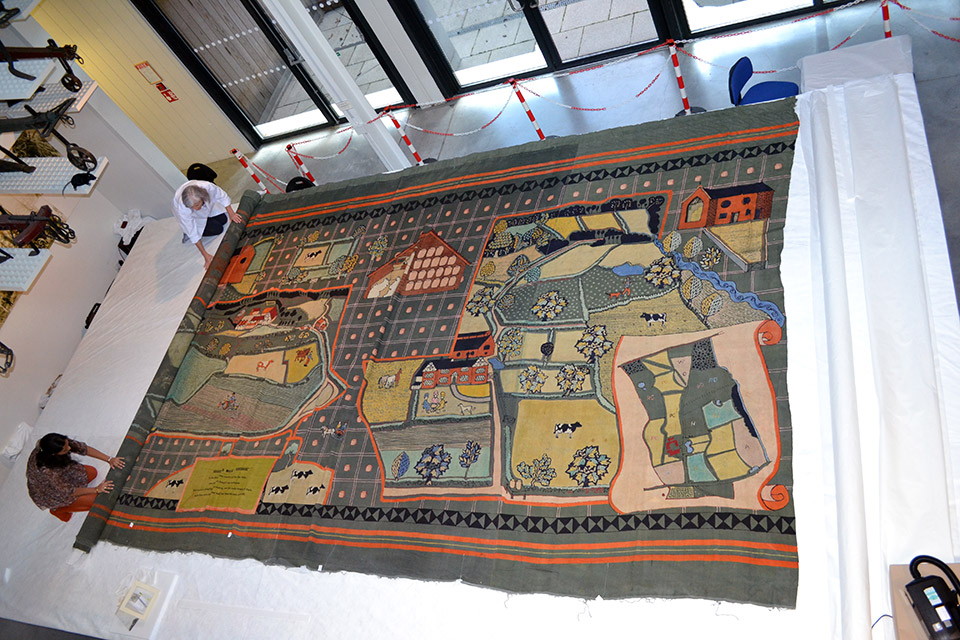Two oversized, resist-dyed wall hangings by Michael O'Connell for the Festival of Britain Exhibition, 1951: conservation, display and storage
Description
Two of seven resist-dyed panels, each measuring over 7 metres wide and nearly 4 metres long; designed and made by textile artist, Michael O’Connell, to hang at the Festival of Britain Southbank Site in 1951. These two hangings depict scenes of farming life in Cheshire and Kent. Resist dyeing techniques, involving lino prints and brushes to apply dye pastes, have been used to create the brightly coloured polychrome scenes. Embroidered highlights are worked in silk floss.
Each hanging comprises four widths of plain weave, regenerated cellulose fabric, butted selvedge to selvedge and connected with a single row of hand-stitches. The original hanging mechanism comprises a curtain tape, machine-stitched to a long narrow band of matching fabric.
Client brief/Role of object
To make both hangings sufficiently stable for eventual display, hanging from Velcro™ support mechanism and resting upon a sloping board, within a bespoke display case. Provide advice on display, as well as advice on handling the hangings during installation, de-installation and storage.
Condition before treatment
Overall, the fabrics appeared structurally sound. They were covered in a layer of loose particulate soils and marked with ingrained soils and stains in numerous areas. The hangings were very creased with some sharp folds. Some hand stitched seams and hems had failed; some later repairs were causing damage. There were several holes in ‘Kent’.
Treatment
The conservation treatment was carried out on-site at the Museum of English Rural Life (MERL) in a large roped off section of the museum gallery.
Both faces of the hangings were surface cleaned to remove loose particulate soiling. Damaging repairs were removed. Following dye fastness and humidification tests, each panel received contact humidification treatment to relax creasing and distortions and reduce stress on the fibres. Seams were reinforced with conservation stitches, and supported onto dyed cotton patches where necessary. Each hole was supported onto custom-dyed patches of cotton and secured with conservation stitching techniques. Further support was provided by custom-dyed, colour-matched protective overlays of conservation grade nylon net.
Following conservation treatment, a continuous length of cotton-faced Velcro™ hanging tape was hand-stitched to the entire width of the top edge of each hanging.
Each conserved hanging was rolled flat onto a padded roller and stored in a customised box with hammock support. The hammock provides gentle and even support along the entire length of the rolled textile during storage and keeps the roller stable during handling and transportation in the box.
Condition after treatment
Each hanging responded well to treatment. Surface cleaning was effective at removing loose fibres and fine particulate soils. Humidification was effective in relaxing creasing and easing distortions. The hangings are more stable as a result of the stitched support. Whilst in storage, the hangings are well supported on their padded rollers.
Prior to the new galleries opening in October 2016 ‘Kent’ was installed in a bespoke case, supported on a sloping board and by the evenly tensioned Velcro™ hanging mechanism. ‘Cheshire’ was placed in rolled storage, located in a customised section at the back of the case. The hangings will be displayed in rotation for five years each. ‘Cheshire’ is scheduled for display in 2021, at which time, ‘Kent’ will be prepared for rolled storage.
Further information
http://www.reading.ac.uk/merl/online_exhibitions...
http://www.reading.ac.uk/merl/online_exhibitions...
http://www.reading.ac.uk/merl/research...
Acknowledgements
Reproduced courtesy of Museum of English Rural Life, University of Reading; Kate Gill Textile and Upholstery Conservation Services © 2017.










